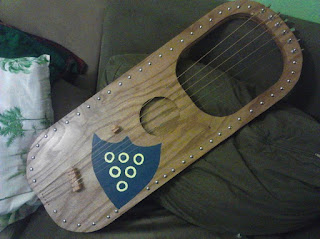Unfortunately, I wasn't able to find the original blueprints I used. It's not that big of a deal really because it's a very basic design. The Center piece of wood needs to be 30"x11 1/2"x3/4". This piece follows visible outline including the rounded 10 1/2"x7 1/2" cutout for the off-hand, but it also includes another cutout that isn't visible for the sound box (a rounded 15"x7 1/2"). The front and rear panel were cut from one piece of panel (cut in two), and have the same outside dimensions and off-hand cutout dimensions as the frame. The rear panel is done, and the front panel just needs the sound box opening shown.
The only additional cutting work needed was at the top-rear. The pins for the tuning keys wouldn't be able to breach 1 1/4" thickness. I Ended up doing a 1/2" cut away that barely runs the area covered by the tuning keys. In the picture with a crack of my previous post, you can easily see this area. The rear panel was added afterward.
The blueprint is a little different in regards to the bridge(s). I chose to use standard guitar strings (0.052", 0.042", 0.032", 0.022", 0.015", and 0.011"), but I wouldn't suggest this. Instead of the wide variety of strings a guitar would use, you should get strings that the gauges aren't so disparate (like 0.032" ,0.027" ,0.024" , 0.023", 0.019", and 0.017"). This way you don't need worry about the pressure. The bridge just needs to be functional as the action doesn't really matter, because there are no frets.



